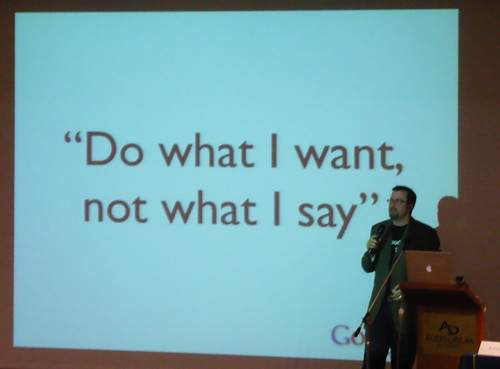 The goal of the IT department is not to make friends. Nor is it a good idea to follow the old thinking that staff in your organization are your customers. IT should act as a partner.
The goal of the IT department is not to make friends. Nor is it a good idea to follow the old thinking that staff in your organization are your customers. IT should act as a partner.Whoa, slow down Steve, what does that have to do with the IT Planning and Prioritizing chapter by the brainiac Peter S. Campbell in the NTEN book, Managing Technology to Meet your Mission? Well, if you would be more patient, I will get there. I was trying to think what I could add to Peter’s chapter without just repeating his totally accurate and well thought out methodology. Because I cant compete with his knowledge on this topic.
However, I think an element that should be stressed when Peter talks about building that integrated plan that includes technology, is understanding how IT is seen by the org. We can write the best plans, set goals, define metrics and have all the best intentions, but if IT doesn’t have the relationships it needs they wont be acted on.
If you think of the staff in your organization as customers, then your ultimate goal would be to meet their needs working with the motto that the customer is right. In this approach you react to the requests and needs of your customers. Your role is to provide the solution, support or training that they tell you they need.
If you strive to have the friendliest, well liked relationship with the staff, then all you do is strive to make them happy. But sometimes we have to push back on some ideas in order to balance the needs of the full organization. We simply cannot make everyone happy all the time and be their BFF.
We have to act as a partner, we are all working toward the same mission. The relationship between IT can be a friendly one, but our allegiance should lie with the mission and strategic plan. As a partner we work with the other departments, not for them as customer implies.
So tying this all back to Peters “spot on” description about IT priorities and planning. Our ability to participate in the planning process and get invited to the table with access to provide input depends on the role we play. If we are simply taking orders, then the IT priorities will be subject to whimsical changes. If we are there to be their friends, will they heed our advice and expertise?
After saying all of that though, you would be mistaken in not reading Peter’s chapter and implementing the process he recommends. You may just want to be sure you keep the whole picture in mind and read the rest of the book too. The best laid plans….
Over 11 weeks I am doing a themed series of blog posts. Each week I will write about a chapter of the book called Managing Technology to meet your Mission. This week is on the 4th chapter about IT Planning and Prioritizing. You should totally buy the book. (In case you are wondering, I am volunteering to do this, I am not getting paid or in any other way reimbursed for this. I just love NTEN and their events.)
Flickr photos by kalandrakas and by Claudio Cicali and by LollyKnit



5 comments:
Nice piece, Steve, although I do believe that IT should be a friend to the organization and the organization is our customer. Kind of an odd thing to draw from my article, which is heavily focused on integrating IT decision making into overall organizational planning.
I think you might have jumped on my case that the two biggest mistakes made in organizations are making technology investments without IT input, and making technology investments without non-IT input. I consider either/or a recipe for failed investments. That doesn't mean that IT's priorities trump everyone elses, by any means. Again, technical planning has to be in support of overall organizational strategies, and technical decisions have to be made by a combination of techs and end-users, so that the result is software that meets user needs while it complies with overarching platform requirements.
The mistakes are made when, say, development goes and purchases a donor database without worrying about how well it integrates with an online system or finance. IT can look at a big picture, arbitrate, and, at the same time, make sure that the technology purchased isn't substandard or obsolete. But we definitely are a service department in our organizations, and we operate best when people trust and appreciate what we offer. So your headline leaves me a little worried that I didn't communicate well in my chapter.
Hi Peter, Thanks for the comment. I guess to clarify, the thoughts in my blog were not conclusions drawn from the chapter that you wrote. Rather in my experience I have found that technology planning is often exaggerated and more complicated because of the emotions and feelings that are tied to the relationship between IT and the org.
We need to strike the balance between being a friend, service provider and partner. We cant just be one and we always need the partner role.
Where I was trying to go with my post was that even if you are able to integrate IT decision making into the overall organization planning, often individual strategy, department or project decisions get swayed based on organizational structure and relationships. So that integrated plan is interpreted and implemented based on how individuals see the role that IT plays, regardless of how the plan was created.
I cant stress enough that there is nothing in your chapter that I disagree with. I have just run into many situations where the plan is skewed in light of budget or changed circumstances, then it comes back to how well valued IT is as a partner. When I have the ability to control an IT strategy, I will be following your chapter and asking you questions, which will lead to an IT dept that is valued and trusted.
I wholeheartedly agree that establishing strong relationships across departments is critical. But, in an org that lacks a planning framework(such as the one(s) I wrote about), the relationship building can skew toward favoritism and other biased priorities that might not be healthy for the organization. The planning framework puts all key decisions in the open, weighed by relevance to mission. Without the framing, all too often, key budget and strategic decisions lie just as much on who enjoys having lunch with whom as they do on mission effectiveness. But without the relationships, the framing can be too abstract for people to really get, and the projects can suffer due to lack of common understanding.
I think this is what you're talking about -- IT priorities can't be based on trying to please everyone. If the customer, who is always right, says "I want to track my donors in Excel", we're not doing an organization any favors by accommodating them, when Raiser's Edge or the equivalent is surely what the organization needs. We can't say yes to every request, as some of those "yeses" would create integration and service issues down the road.
But I think it's equally important for IT staff to have a service-oriented approach. A consultant who helps me install the wrong software is not a good consultant, and I'm clearly a customer in that relationship. Being a good service provider pretty much requires that you know how to say no and look after broader interests. So I jumped a little at the title of your post -- I think it's far more nuanced. And, again, the tools that allow IT to communicate the difficult messages -- and to be service-oriented friends who are allowed to say no to poor strategic choices -- are the framing and planning tools that I'm advocating for.
Great post Steve! I strongly believe IT should be viewed as a business partner, not a service provider. I posted a few thoughts on my blog.
http://theartoftechnology.blogspot.com/
John, that is a great post on http://theartoftechnology.blogspot.com/ that sums up what an IT Partner should look like which shows the difference between a friend or service provider.
-Strong Communications Skills
-Cultivator of IT/Business champions
-Budget Focused
-Strategic Planner / Partner
-State of the Self
-Problem Solver / Troubleshooter
-Keeps finger on the pulse of the tech industry
It may just be a difference of words how you describe yourself, but often the way that you think about yourself begins to define how people treat you.
Hmmmmm
Post a Comment